Blog
Archives
.
. . from 2012 to current
MONDAY
AUGUST 31 - 2015
Emsworth
Show
The weather
for today's annual show at the Emsworth Recreation
Ground was not nearly as bad as last year which was a
total wash out. Light rain in the morning eased off in
the afternoon and it turned out to be a very pleasant
day. I went over this afternoon with Jean and two
grand daughters who are staying with us for a
while.
The Brook Meadow Conservation Group stall was looking
very good with fresh photographic displays of
conservation work and wildlife. It was manned mostly
by Jennifer Rye, Maurice Lillie and David Search who
did a great job. It was good to see Caroline French
following her successful nurturing of Hedgehogs in her
garden. Maybe she will have a Hedgehog stall next
year?
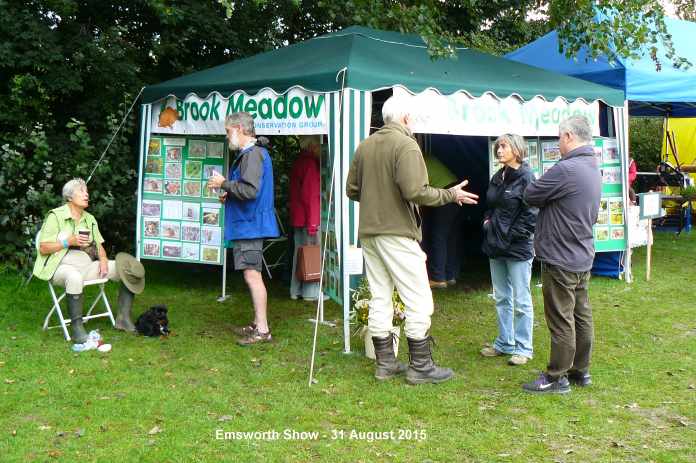
I picked a bucketful
of wild flowers from the meadow for the Brook Meadow
stall which was being closely inspected in this photo
by Dave Lee, one of the volunteers.
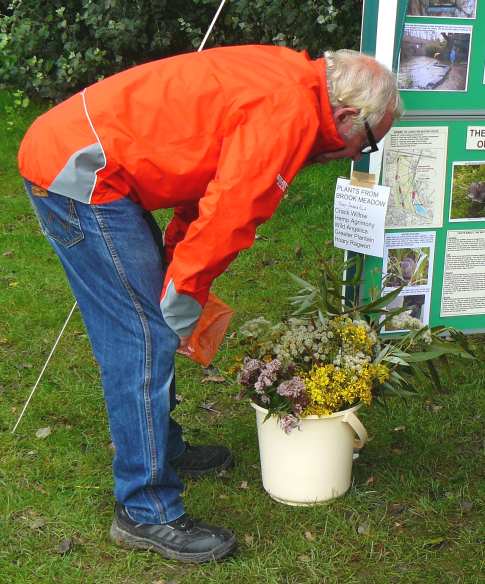
Next door was the
Emsworth Waysides stall manned by Jane Brook.
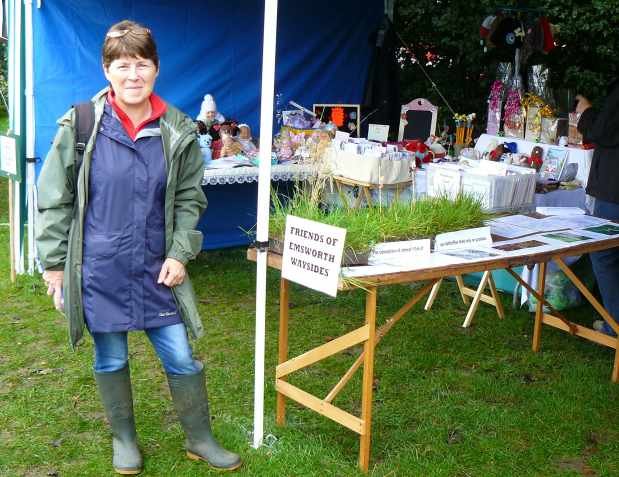
I was also interested
to see a BTO Garden BirdWatch stall manned by John
Goodspeed - a first for the show.
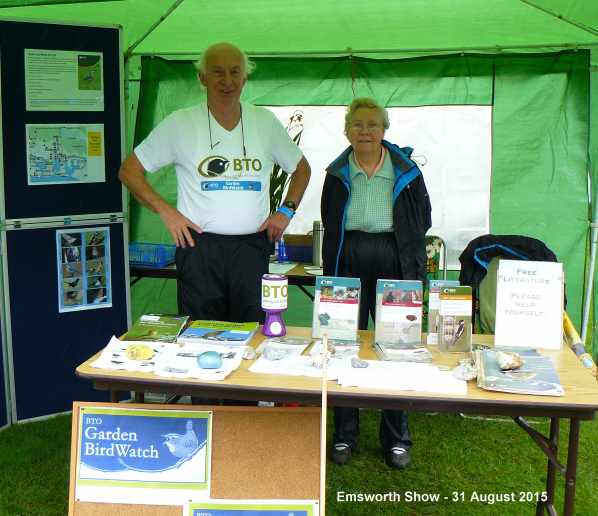
Lily and Iris, my
granddaughters, were thrilled to have the opportunity
to hold a Little Owl and a Tawny Owl at the falconry
stall and I could not resist a quick close-up shot of
the birds while they were doing this. The Little Owl
is on the left with its glaring yellow eyes fixed
solidly on me! In contrast the eyes of the Tawny Owl
on the right are more gentle and sleepy.
Finally, I was dead
chuffed to get a 3rd prize for one of the two photos I
entered in the show's photographic competition.
Clearly, beginner's luck as this was my first ever
entry. It was a family shot of three grandchildren
dancing down the millpond seawall. If you want to see
it go to . . . http://familyfellows.com/0-0-0-x412-ew-lily-joe-iris-arms-13.07.14.jpg
Albino
Squirrel
Graham Petrie
managed to get a shot of the albino squirrel going
into the Victorious Festival in Southsea yesterday. It
posed on one of the chestnut trees in Malvern
Road.
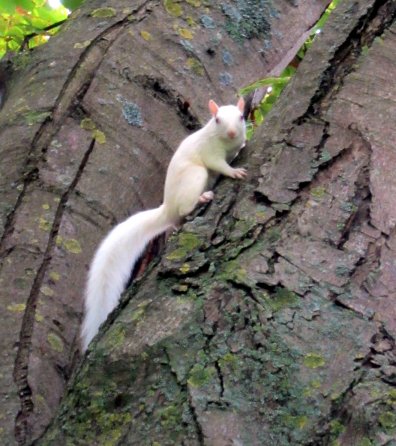
SUNDAY
AUGUST 30 - 2015
Garden
Spiders
Following on
from the pair of courting Four-spot Spiders
(Araneus quadratus) that Malcolm
Phillips photographed on Brook Meadow yesterday, this
afternoon Chris Oakley had a pair of courting Garden
Spiders (Araneus diadematus) in his
garden. The female is on the left and the smaller male
on the right.
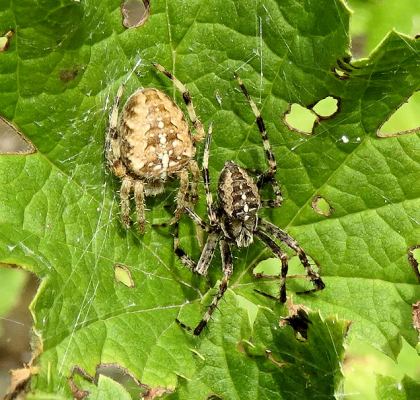
I hope the male fared
better than the one caught on camera in this YouTube
video in which the poor fellow was consumed by the
female before he managed to complete the act . . . .
https://www.youtube.com/watch?v=NePogqkltAo
Warblington
shore
Peter
Milinets-Raby was out this morning for a short walk
along the Warblington shore to catch the tide pushing
in (8:32am to 10:17am).
The bird of the morning (at 8:55am) was an Osprey that
flew along the channel from Thorney, circled low over
the water by the Hayling Bridge, occasionally carrying
out abortive dives, before flying back to my position
at Conigar Point. It circled around searching for
fish, then headed slowly back to Hayling Bridge and
over into Langstone Harbour. Eight minutes of cracking
views in the scope. Because of the Osprey, waders were
in short supply.
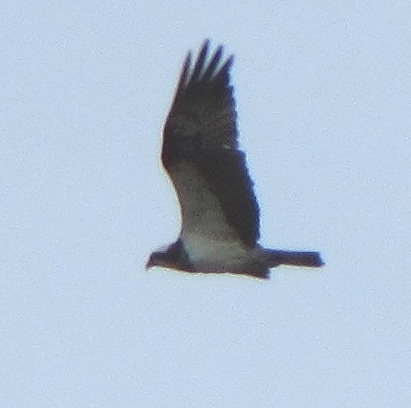
Conigar Point: 4
Common Gull, 1 Ringed Plover, Adult winter
Mediterranean Gull, A single Yellow Wagtail in the
SSSI field with the friends of Number 58! 2
Greenshank, 7 Lapwing, 1 Grey Plover, 2 Willow
Warblers in the Tamarisk Hedge (one briefly
singing).
Off Pook Lane: 12 Bar-tailed Godwit, 32 Dunlin, 4 Grey
Plover, 88+ Swallows (in small groups moving west), 11
Greenshank (6 of them with colour rings - NR//-+YY//-
& G//R+YN//- & RG//-+YY//- & G//R+LN//-
& G//R+GR//- & G//R+BRtag//-)
And in the hedge along the shore were an impressive
flock of at least 62+ House Sparrows - difficult to
count, could easily have been up to 20+
more
SATURDAY
AUGUST 29 - 2015
Brook
Meadow - mystery Cranesbill
I went over to
the meadow this morning mainly to measure the small
Cranesbill flower that I discovered on the
orchid area of Brook Meadow yesterday, hoping this
would help to establish the species. As can be seen
from the photo, the flower measures no more than 6mm
across, though some of the petals have been nibbled
since I saw it yesterday.
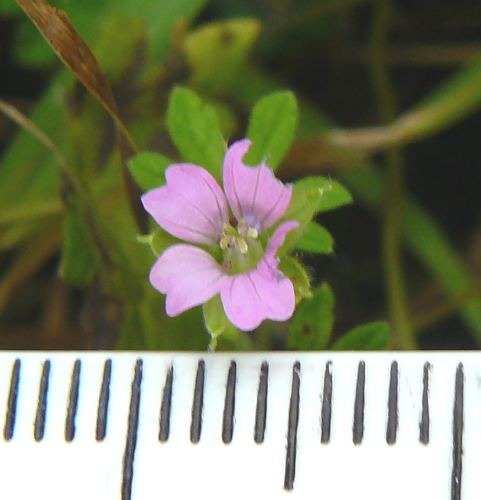
This means it is at
the top of the size range for Small-flowered
Crane's-bill (4-6mm) and at the bottom of the range
for Dove's-foot Cranesbill (6-10mm), so the result is
indecisive between the two species. However, I am
inclined towards Small-flowered Crane's-bill
since the photo seems to show just 5 stamens with
anthers; if it were Dove's-foot Cranesbill one would
expect to see all 10 stamens with anthers. This
feature shows more clearly on the photo I took
yesterday.
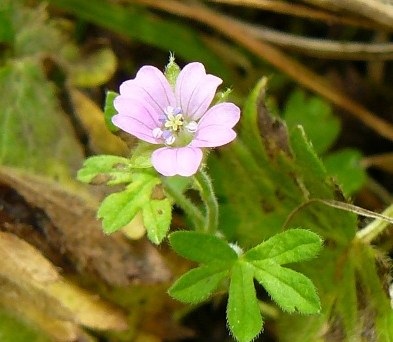
I found a very fresh
Speckled Wood butterfly resting on the ground
near the recently cleared Crack Willow on the north
meadow. This must be one of the new summer brood.
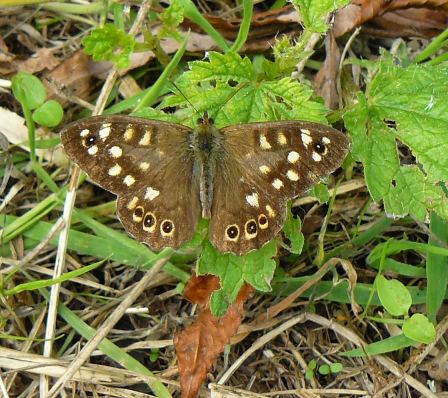
The five
hibernacula were completed by the ecological team
yesterday in the west side of the north meadow and can
easily be seen from the main river path. They consist
of piles of logs covered over with layers of small
twigs. Hopefully will be home to reptiles relocated
from local building development sites.
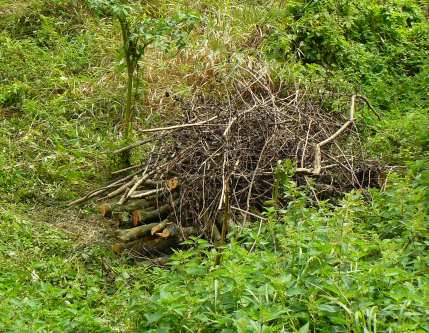
For more details about
this work see report from Maurice Lillie at . . .
http://www.brook-meadow.hampshire.org.uk/bm-diary-2015b.html
As expected, the
Environment Agency started work this morning on
the new flood defence bund around the garden of
Gooseberry Cottage. I met a couple of chaps in the
channel leading from the south meadow to Peter Pond
where one of them was drilling a second hole through
the concrete wall to facilitate the flow of flood
water from the meadow into the pond. This is the first
stage. The main work will be reinforcing the existing
earth bund around Gooseberry Cottage.

Malcolm's
news
I met Malcolm
Phillips on Brook Meadow. He had seen several birds in
the bushes near the old gasholder including these two
migrants, Chiffchaff on the left and female
Blackcap on the right. Let's hope they bred
successfully on Brook Meadow this year.
Yesterday Malcolm got
a shot of a male Common Blue with bright blue
upper wings; today he got one of a female with brown
upper wings feeding on Common Fleabane.
CORRECTION
- Malcolm's
photo was a Brown Argus - note the two black
spots on the upper wings.
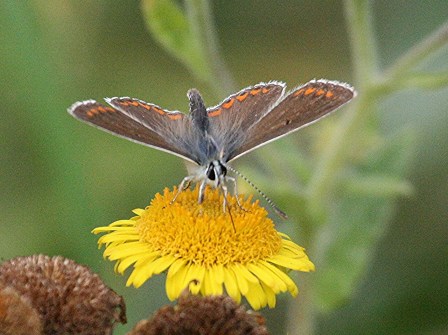
But the most
interesting photo that Malcolm got was of what he
thought at first were two different species of spider
in the same web. In fact, I think what Malcolm got was
a female Four-spot Spider (Araneus
quadratus) being courted by a male spider of
the same species. The male spider is much smaller than
the female and needs to approach her very carefully,
and to get away quickly after the mating act, to avoid
being eaten.
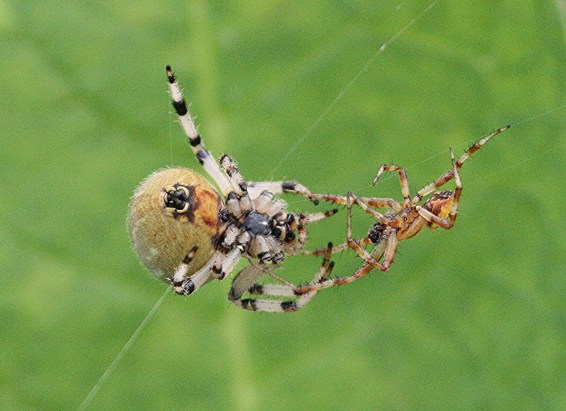
Long-tailed
Tits galore
Patrick Murphy
had 8 Long-tailed Tits feeding on the fat ball feeder
in his North Emsworth garden in the rain this
afternoon. There were at least another 2 waiting
nearby for their turn. What a crush!
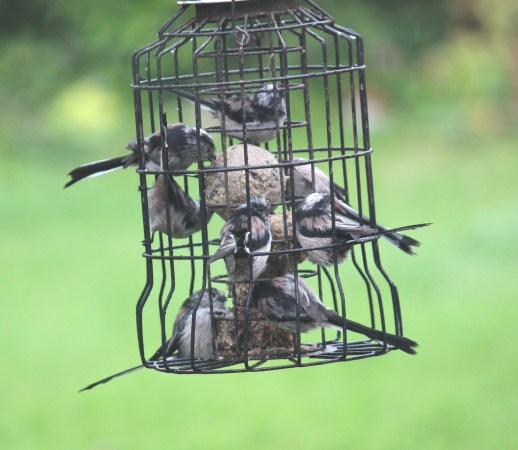
Langstone
Mill Pond
Peter
Milinets-Raby took his son Aleksandr out for a brief
walk along Wade Lane to the Langstone Mill Pond
(10:45am to 12:15pm) during which he saw 5 birds of
prey!
Along Wade Lane: The resident family group of Swallows
(19) were very agitated and the culprit was a
Hobby, which was quickly chased off by a couple
of brave birds.
1 Spotted Flycatcher typically fly-catching from the
big tree in the first paddock field - only the second
I've seen in this area.
A good record of 3 Swift flew over together (almost
certainly these will be the last I see this
summer).
Langstone Mill Pond: A very hungry family of Mute
Swans were pushing all the eclipsed Mallard away as
each toddler walked by with a plastic bag of bread!
Pair of eclipse plumaged Gadwall - getting harder to
identify as they get tatty. 26 roosting Little Egrets
seeing out the high tide. And, a female Mallard with a
4/5 day old duckling
Over the northern shore of Hayling, a warm thermal
pushed into the air, 2 Buzzards, an
Osprey (this slipped away quickly into
Langstone Harbour), a Peregrine and a
Sparrowhawk - the later harassing the two
Buzzard with lots of dive bombs.
FRIDAY
AUGUST 28 - 2015
Brook
Meadow
I had a walk
through the meadow for a couple of hours this morning,
mainly examining the flower heads of Hogweed and Wild
Angelica for insects. The south meadow is currently
dominated by the tall plants of Wild Angelica
with their distinctive rounded umbels towering over
everything else. I don't recall this plant being quite
so abundant as it is this year.
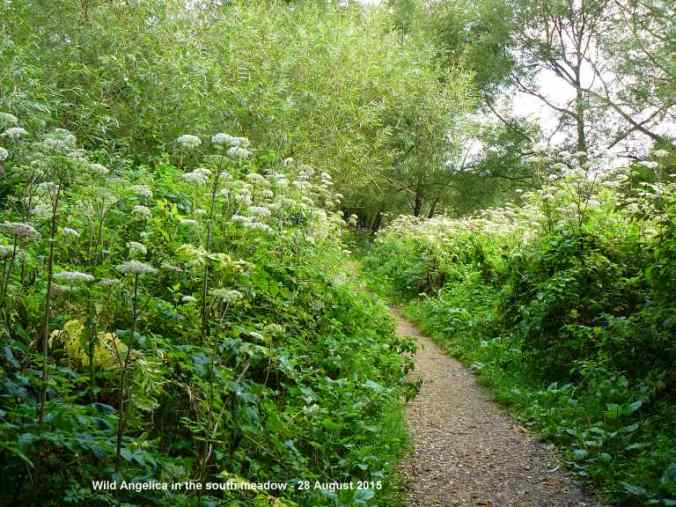
For the second day
running I found what I think is a Dead Head Fly
(Myathropa florea) feeding on a Hogweed flower
head. It gets its common name from the distinctive
marking on its thorax which is thought to resemble a
human face or death mask.
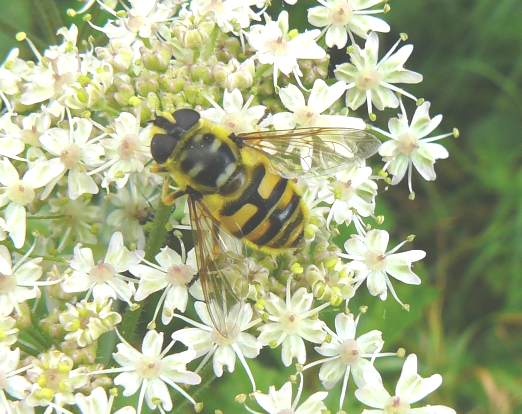
I also found what I
think is a Soldier fly which had its wings
folded over its back while feeding, unlike hoverflies
which spread their wings when feeding. I think it
might be a Banded General (Stratiomys
potamida) which is the most widespread Soldier
Fly in England and mainly a lowland species. The
flight period is from May to early Sept.
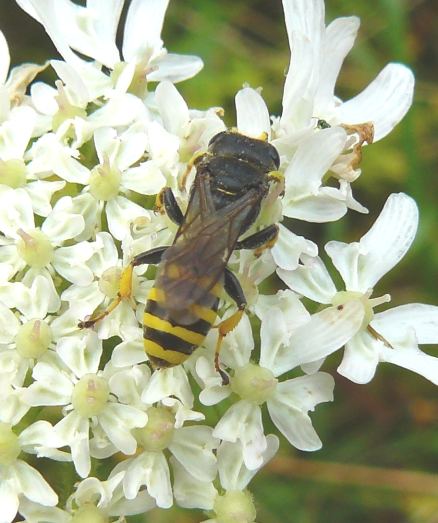
Also, on the Wild
Angelica flowers I was interested to watch a dark
brown Shield Bug extend its antennae straight
out in front, maybe as a reaction to my close approach
to get a photo. I have not seen it in this pose
before.
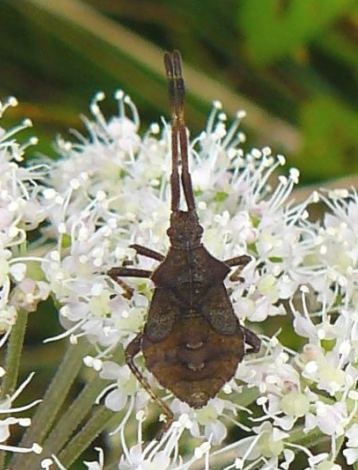
While walking through
the tangled vegetation on the orchid area, I came
across a single tiny pale pink flower with 5 notched
petals and partially lobed leaves. My guess is
Dove's-foot Cranesbill - or could it possibly
be Small-flowered Crane's-bill? Amazingly, if it were
either of these it would be the first to be recorded
on the Brook Meadow site!
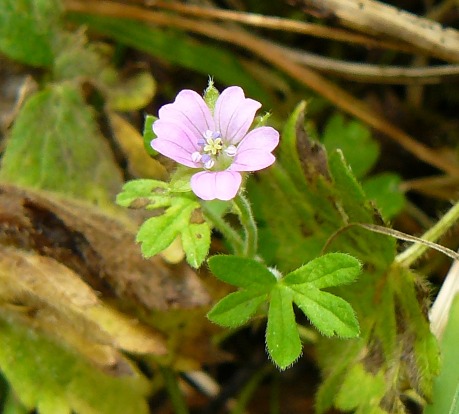
I was surprised to see
a flowering of what I assume is Redshank
pushing up through the tangled vegetation on the
river bank near the north bend. A first for this year.
The only alternative is Amphibious Bistort.
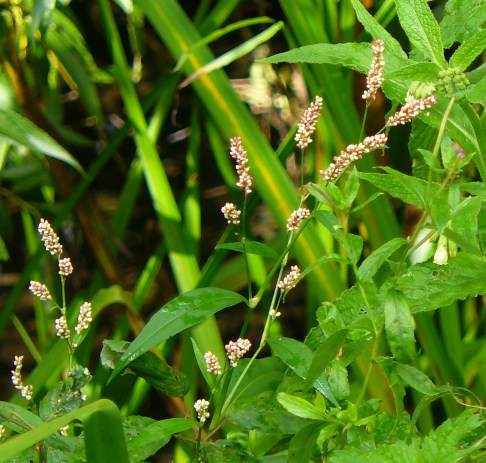
What is left of the
Strawberry Clover after the inadvertent mowing
of the path round the Lumley area by the conservation
group is now starting to fruit.
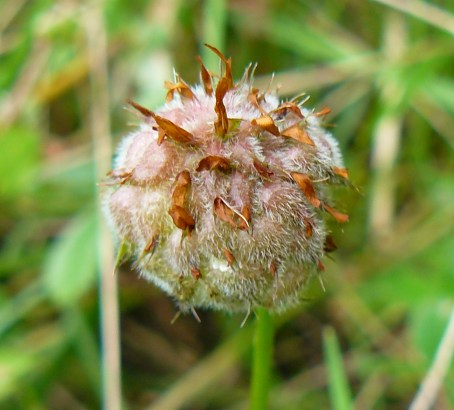
We have an interesting
growth of Straw Cup Fungus (Peziza
vesiculosa) on the naturalised extension to
the new wall containing the river in the north-east
corner of the meadow. Here are two examples of their
tough bowl-shaped fruiting bodies.
We have had several
records of this fungus on Brook Meadow over the years
the last being on 20-Feb-14 when it was found growing
in clusters on a pile of rotting grass arisings in the
north-east corner of the meadow. These cuttings were,
in fact, used by the conservation volunteers to cover
the ugly concrete bags of the newly constructed flood
wall, taking with them the spores of the fungi.
Finally, I found what
I am fairly sure is a primary wing feather of a
Carrion Crow (28cm in length). All birds change
their feathers at about this time of the year, called
moulting.
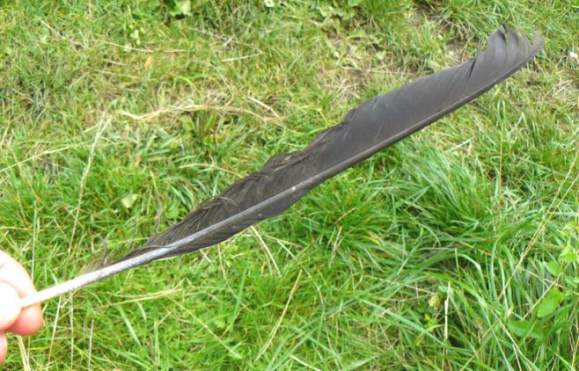
While on the centre
meadow I met Malcolm Phillips and we watched a male
Common Blue butterfly fluttering around low
over the grassland. Common Blues tend to fly low,
unlike Holly Blues which invariably fly high. Malcolm
managed to get a nice photo of the insect when it came
to rest. We also watched a Painted Lady flying briskly
around the area before disappearing into the trees of
Lumley copse. Probably fresh from flying across the
English Channel! But Malcolm did not get a photo of
this one. After I left Malcolm also got this splendid
photo of a female Common Darter.
As I was leaving the
meadow at the Seagull Lane entrance, I met two
ecologists from the Ecology Co-Op who were preparing
to build five hibernaculums in preparation for the
translocation of some Lizards and Slow-worms from a
building site. Here are Sam and Bryony with logs
making the first of the hibernaculums. We shall
publish more details of this work later.
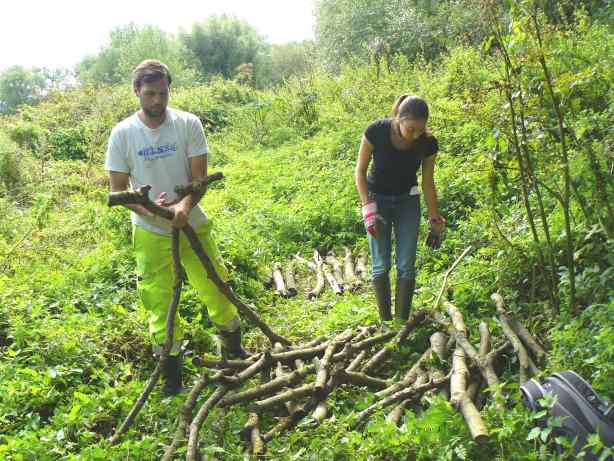
Hampshire
Farm
Chris Oakley
was on the Hampshire Farm site this afternoon and
spotted a group of at least five baby lizards.
Here is one that Chris got with a 16 spot Ladybird for
company. They were sunning themselves on one of the
left-over refuge mats. This little one is barely 4 cm
long and Chris thought looks like a tiny dragon.
Chris also noted a good selection ichneumon flies
around the remaining Wild Carrot and sent the
following photo of what he thinks is Pimpla
rufipes.
Caroline's
Hedgehogs
Caroline
French sent the following update on the hedgehog
situation in her garden.
"I
still have the female hedgehog living in the original
box and at least two of her brood still visiting the
garden, as well as at least one other male. This makes
a minimum of four hedgehogs regularly coming, but I
suspect it is probably more like six. I think the
large male may even be living somewhere at the bottom
of the garden underneath the ivy, as he seems often to
emerge from that area. A couple of weeks ago, I
thought all the young hedgehogs had disappeared, bar
one. However, I was thrilled to look out on 12th
August and see three of the young hedgehogs plus one
adult feeding together at the feeding station (see
photo).
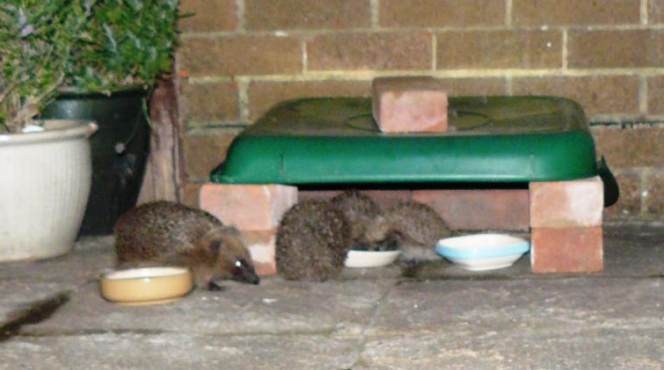
It
seems that hedgehogs don't follow a particular pattern
in the times that they emerge or where they head to
first to feed. I have even seen the female emerge from
the box and head straight under the fence into my
neighbour's garden, rather than towards the feeding
station. This suggests to me that they are not
desperate for food.
Female
emerging from box
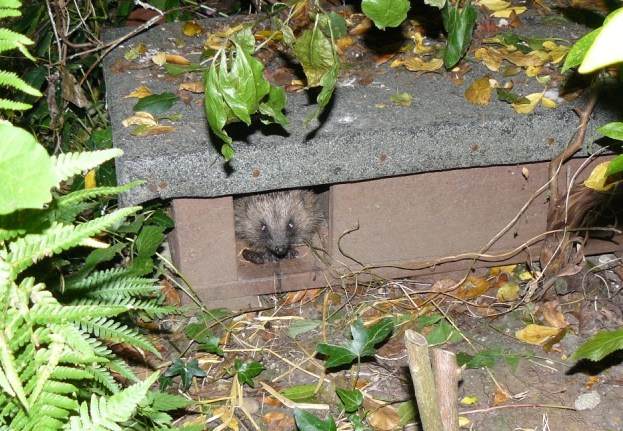
A few
days ago I put a second hedgehog box in the garden,
under the same bush as the original one and I was
amazed this morning to see that it looks very much as
though it has already been occupied! I will be
interested to see whether this is a second hedgehog or
whether the female has decided to move into a new box
with fresh bedding in it. I have bought a third box
which I am going to site under my beech hedge in the
front garden, but after that I think I will have run
out of suitably sheltered and shady places to put
boxes.
According to Pat Morris in his, 'The New Hedgehog
Book,' hedgehogs are not thought to be very
territorial so it may be that my garden, although
small, might be able to provide safe homes for more
than one hedgehog. We'll see what happens. From time
to time I witness a bit of pushing and shoving between
two hedgehogs, but nothing ever looks very violent. I
did see one male charge a larger male, which just
curled up into a ball until the assailant had gone off
to continue its pursuit of the female!
Readers
or your blog might be interested to know that the
Chichester-based company, 'A Chip off the Block', who
made my latest box, will have a stand at the Emsworth
Show this weekend, so anyone who would like to buy a
box could possibly pick one up there. Mine cost
£25. My immediate neighbour and a work colleague
have both asked me to buy one for them.
Hedgehog
Street are hosting a 'Day of the Hedgehog' event on
21st November in Telford - I am very tempted to
go:
http://www.hedgehogstreet.org/pages/hogcon15.html
Monarch
and Martins in Funtington
Paul Cooper
was excited to get a Monarch butterfly in his garden
in Funtington, quite unlike any butterfly he's ever
see before. Paul admits it probably came from a
butterfly kit, but one never really knows for sure.
This question came up on this blog on June 20th
concerning the origins of a Monarch seen in Cosham.
However, the ready availability of Monarch butterflies
on the internet for Weddings, Funerals, etc. makes one
wonder.
Paul also reports the
House Martins that regularly nest on his house
did build a nest this year, but quickly deserted it.
However, he says there are lots of House Martins
around Funtington so they obviously have nested
nearby.
THURSDAY
AUGUST 27 - 2015
Brook
Meadow
I had a slow
walk down the main river path from the north bridge
this morning, stopping every few yards to examine the
insects and spiders resting on the nettle leaves. Here
are just a few of them that I snapped and that I felt
fairly confident about an identification from
Chinery's Collins Guide to Insects. There were many
others that I just enjoyed.
There were several shield bugs: on the left is what I
think is a Sloe Bug (Dolycoris baccarum)
which feeds on a wide variety of herbaceous plants as
well as Blackthorn according to Chinery (p 74). On the
right is a nymph Green Shield Bug (Palomena
prasina) which Chris Oakley also had recently on
Hampshire Farm (see illustration in Chinery p.75).
Spiders are also
emerging: on the left is a Garden Spider
(Araneus diadematus) with a prey in its web. On
the right - one of many Nursery-web spiders
(Pisaura mirabilis) lying in wait for its prey
with its front legs typically stretched out.
There were plenty of
hoverflies. On the left what I think is a Dead Head
Fly (Myathropa florea) which gets its
common name from the marking on its thorax which is
thought to resemble a human face or death mask. They
feed on pollen and nectar and appear on various plants
including Hogweed and Cow Parsley between May and
October. On the right is a female Dark
Bush-cricket with a long curved ovipositor showing
well.
Finally, what looks
like some sort of sawfly, though I do not know what
species. Possibly Tenthredopsis litterata
?
See . . . http://www.naturespot.org.uk/species/tenthredopsis-litterata
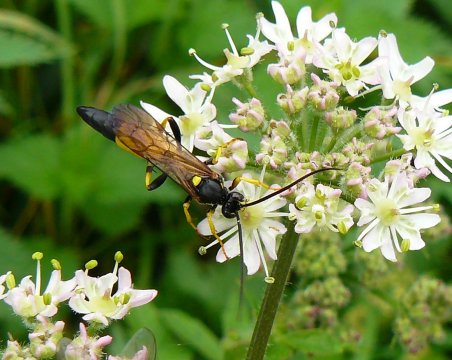
I also noticed
Purple Loosestrife struggling through the
tangled vegetation in the river south of the north
bridge.
Warblington
shore
Peter
Milinets-Raby was out this morning to walk along the
Warblington shore 6:20am to 8:40am - tide coming
in.
Ibis Field: Male Blackcap.
Conigar Point: 12 Sand Martin heading south, 1
Black-tailed Godwit, 19 Dunlin, 9 Lapwing, 11 Grey
Plover, 1 Greenshank, 1 Whimbrel, 1 Ringed Plover, 1
Lesser Black-backed Gull, 1 Willow Warbler in the
Tamarisk Hedge (not much else).
Off Pook Lane: 59 Grey Plover in pre-roost gathering,
3 Black-tailed Godwit, 7 Greenshank (4 with colour
rings N//R+RY//- & G//R+BR///- & NR//-+YY//-
& RG//-+YY//-), 56 Redshank (6 with colour rings
-//B+B//RR & -//B+B//ON & -//B+B//OY &
-//B+B//YR &-//B+B//NG & -//B+B//OO), 82
Oystercatcher in pre-roost gathering, 26 Dunlin, 1
Bar-tailed Godwit (summer), 2 Juvenile Black Tern
feeding in the middle of the channel with 3 juv
Common Terns.
Langstone Mill Pond: Pair of Gadwall in eclipse
plumage, 1 Reed Warbler.
WEDNESDAY
AUGUST 26 - 2015
Emsworth
Millpond
I had a walk
around the millpond this morning in between the rain
showers. The regular Mute Swan family with 5
cygnets was sheltering from the strong southerly wind
in the corner on Bath Road near the house that used to
be called Tenerife Cottage until the new owners
renamed it Swan House.
The small Mallard family with mum and three
ducklings is still present on the pond. I think there
were about 10 ducklings to start with, but the
surviving three seem to be healthy and growing well.
Here they are snoozing on the seaweed near the road
bridge.
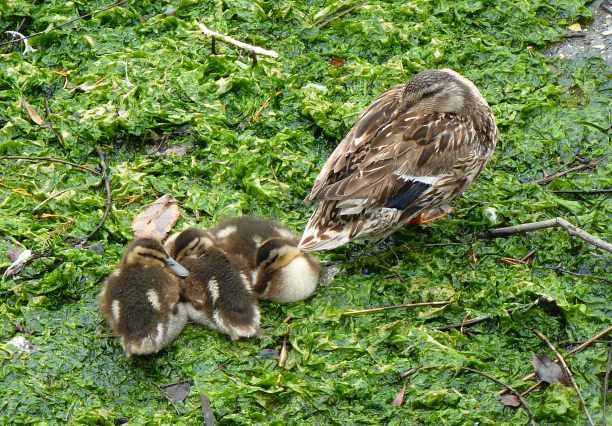
In general, Mallard
numbers on the pond are now fairly high as the
breeding season ends and the birds enter their annual
moult. I counted 84 Mallards (not including the
family) on the pond; the winter peak is usually around
100.
Mallard
eclipse
Almost all the
Mallards on the millpond are in eclipse plumage which
means the normally brightly coloured males (drakes)
are almost identical to the females (ducks). This is
due to moulting. In common with most other wildfowl,
Mallards moult all their flight feathers at once in
late summer and become flightless until the new
feathers grow. This strategy has evolved to make the
males less conspicuous and less vulnerable to predator
attack.
Although the two sexes are alike they can still be
distinguished as shown in this photo that I took today
on the millpond showing a female on the left and a
male on the right.
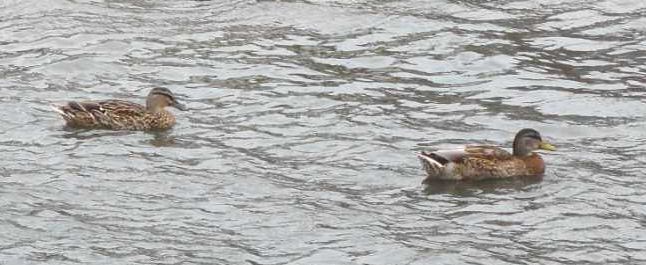
The easiest feature by
which to distinguish the sexes at this time is bill
colour; the male has a yellow bill, whereas the
female's bill is a dull brown. There are also more
subtle differences in plumage which can be seen on
this photo. The breast of the male is red-brown in
contrast to that of the female which is paler and
streaked. The male's black tail also shows up as do
the pale upper wing feathers.
Mystery
falcon - not Kestrel?
Responding to
the report by Peter Milinets-Raby in the blog entry
for Aug 24, Malcolm Phillips is sure the bird he saw
(and photographed) in flight over Brook Meadow on Aug
21 was not a Kestrel. "I have seen and photographed
many Kestrels, but this bird did not look or act like
any I have seen before. I have also looked on the
internet for photos of Kestrels and cannot convince
myself it is a Kestrel."
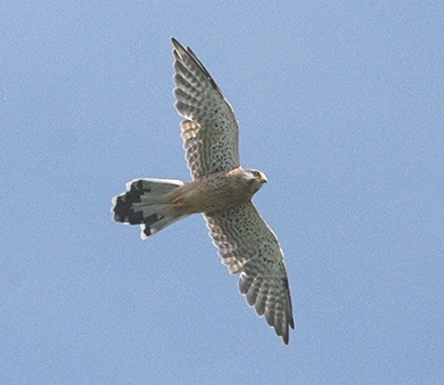
I suppose we shall
never know for certain what the bird was, but if it
was not a Kestrel then there are few alternatives. The
only other serious suggestion came from Ralph Hollins
who thought it could have been a Red-footed Falcon
and, looking at photos of the two birds side, by side
clearly shows their similarity - see blog entry for
Aug 23. However, as far as I am aware, there has been
no other reported sighting of a Red-footed Falcon in
the local area.
TUESDAY
AUGUST 25 - 2015
Water
Vole at Fishbourne
Roy Hay sent
me a nice photo of a Water Vole having a feed in the
stream that runs through Fishbourne Meadows. Gosh, how
I wish we could see one like that on the river on
Brook Meadow.
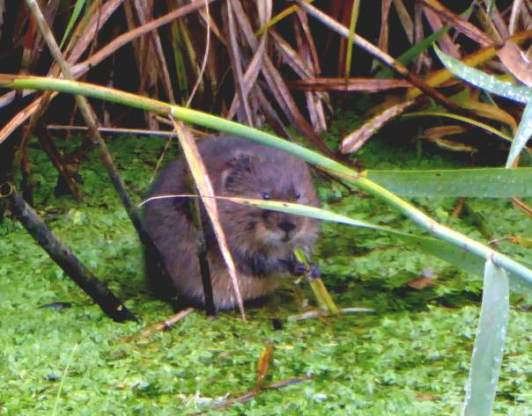
Roy sent another photo
of a not so happy scene of a Water Vole nest site that
was dug out last night, presumably by a fox. The fox
is certainly one of the many predators of Water Voles,
but not on Brook Meadow where foxes are rarely seen.
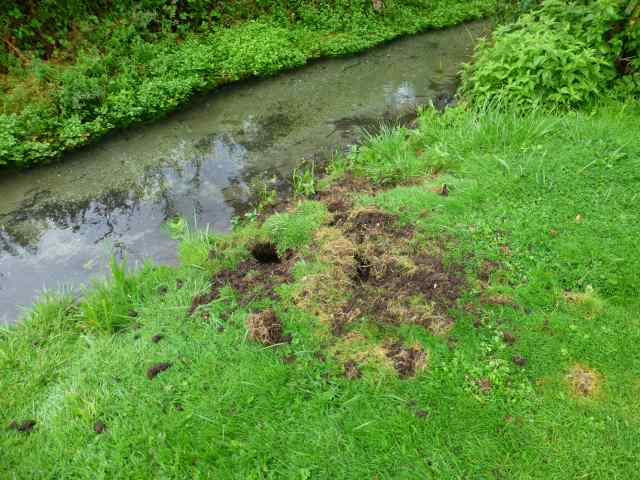
Turtle
Dove at Woods Mill
What better to
brighten up a wet and miserable August day than a
picture of a Turtle Dove. Well, Romney Turner realised
my dream when she sent this super photo that she took
at Woods Mill nature reserve at Small Dole which is
near Henfield in West Sussex. I did not realise that
Woods Mill is the headquarters of the Sussex Wildlife
Trust.
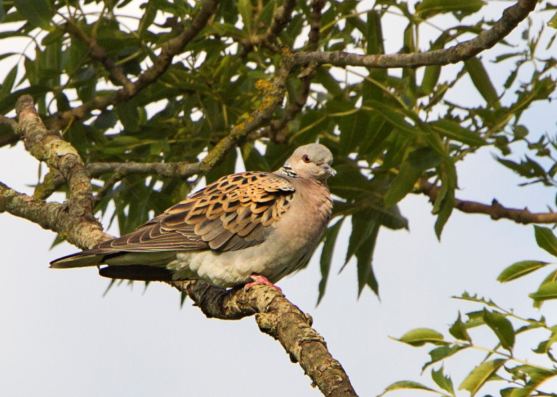
MONDAY
AUGUST 24 - 2015
Mystery
falcon - Kestrel?
Peter
Milinets-Raby is pretty sure that the falcon that
Malcolm Phillips photographed in flight over Brook
Meadow on Aug 21 was in fact a Kestrel.

Peter gives the
following reasons:
1. Pointed wings (No 10 primary tip very short and
virtually equal in length to No. 7 primary tip - Both
short adding to pointed look).
2. Long grey tail, with black terminal band - no other
barring visible, makes this bird a classic male.
3. Dark claws (visible on photo at 400%
magnification).
4. Pale straw yellow feet.
5. Grey hood and moustache of male plumage barely
visible - typical wear of an adult after a long summer
breeding.
6. Kestrels do (annoyingly) glide around in circles
for minutes at a time, just like any other raptor.
They obviously has a unique hunting technique which
can aid Identification!
For
a summary of the local wildlife news over the last two
weeks go to . . .
Wildlife
News Summaries
SUNDAY
AUGUST 23 - 2015
Red-footed
Falcon?
Ralph Hollins
spent some time trying to match up the mystery falcon
that Malcolm Phillips photographed in flight over
Brook Meadow on Aug 21. Ralph agreed with Malcolm that
the bird in the photo did not really look like a
Kestrel, nor did it behave in a typical Kestrel-like
manner. Malcolm's description of the bird 'flying
around for five minutes' did not match his memories of
Kestrel behaviour, which if not hovering to hunt, was
flying directly to a perch. Then Ralph dropped a
bombshell: "I don't like to suggest rarities but after
rejecting all other possibilities I found a photo of a
Red-footed Falcon which seems a good match for
Malcolm's photo" See . . . http://orientalbirdimages.org/images/data/redfooted_falcon_2yr_f_kmo.jpg
Here
are the two images side by side with Malcolm's on the
left and a Red-footed Falcon on the right
The resemblance is impressive!
One major difference
is the tail, which appears to be dark tipped on
Malcolm's photo as in a Kestrel. However, Ralph thinks
the distortion of the tail in Malcolm's photo was
caused by the bird twisting its tail to adjust its
flight path. Also, the colouration of Malcolm's bird
suggests it is a female. Red-footed Falcons feed
mainly on dragonflies, so that might be a reason for
the bird spending some time over Brook Meadow.
The Red-footed Falcon is a vagrant to Britain, usually
about 5-10 annually. It breeds in Eastern Europe and
winters in SW Africa. It is a very rare bird in our
area. The new 'Birds of Sussex' reports a total of 35
sightings up to 2011 with a peak in May and June.
There were no records for August and only one for
September. That is not good news for our Red-footed
Falcon ID as this is clearly the wrong time of the
year for one to be seen. I would be grateful for any
other contributions to the debate.
Mallard
ducklings diving
Chris Oakley
took his usual Sunday morning walk around the town
millpond despite the rain. He noted that the three
Mallard ducklings seemed to have doubled in size since
last week. While watching them he was surprised to see
one of the youngsters actually diving under the water
and he asked how common is diving in Mallard
ducklings?
This question sent me to Google where, as you would
have guessed, there were plenty of examples of Mallard
ducklings diving, including a YouTube video of one
doing just this at . . https://www.youtube.com/watch?v=zjVA-wufGis
Little
Terns
Apparently,
Little Terns have had a good breeding season in
Chichester Harbour with 17 young fledging there to
give the best result since the mid-1970s. I wonder how
they fared in Langstone Harbour?
SATURDAY
AUGUST 22 - 2015
Peter
Pond
Malcolm
Phillips got his first photo of a Kingfisher
for a few months, in its favourite place on the table
at the top end of Peter Pond. And it is a male, for a
change, with all black bill; almost all the earlier
ones Malcolm got were of a female.
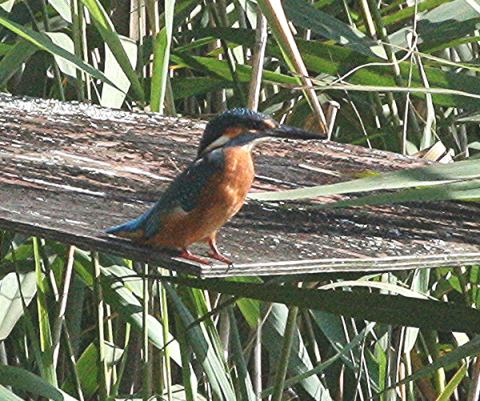
Malcolm also found
plenty of Swallows flying around the edge of
the pond and perching on the overhead cables. They
will be soon be preparing to depart for their long
migration to Southern Africa.
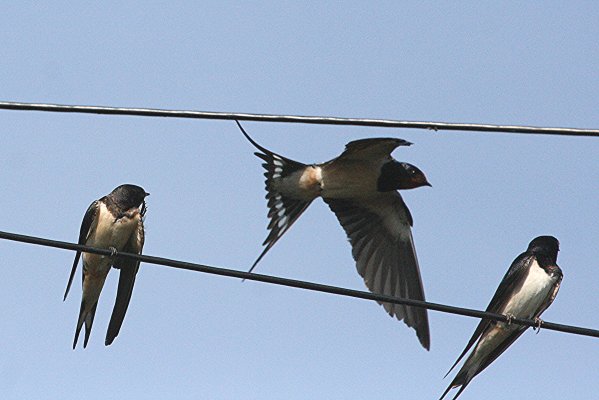
Mint
Moth
Chris Oakley
was interested in the Mint Moth (Pyrausta
aurata) that I had feeding on the mint flowers
in my garden yesterday. He agrees they are abundant at
this time of the year, and in his garden they around
the Marjoram and Thyme both of which attract hoards of
insects. Chris has logged 22 varieties of Hoverfly
alone this year. Chris says there is another mint moth
that is very similar to the Pyrausta aurata and
in fact flies with it called Pyrausta
purpuralis - there are subtle differences but
it's worth looking out for. Here are Chris's photos
with aurata on the left and purpuralis
on the right.
Warblington
shore
Peter
Milinets-Raby popped down to the Warblington shore
this morning (6:25am to 8:16am - tide dropping,
virtually no migrants). The highlights were as
follows:
Ibis Field: 2 Swallows, 1 Green Woodpecker, 2 Stock
Dove.
Conigar Point: 30+ Redshank (three with colour rings -
-//B+B//GG & -//B+B//NY & -//B+B//ON), 1
Lapwing, 10 Grey Plover, 56 Dunlin, 73 Ringed Plover,
1 Common Gull, 1 Greenshank, 1 Black-tailed Godwit, 27
Mallard with 2 Teal flew west and headed for the
Langstone Mill Pond: 2 Great Black-backed Gull, 1
Meadow Pipit over, 2 Yellow Wagtails over.
Off Pook Lane: 4 Common Tern, 16 Grey Plover, 1
Dunlin, 3 Black-tailed Godwit, 4 Greenshank (none with
rings).
FRIDAY
AUGUST 21 - 2015
Mystery
raptor
While he was
on Brook Meadow today Malcolm Phillips got a photo a
raptor in flight, which he could not identify. He said
it was flying over the meadow for about 5 mins before
it went off to the north.
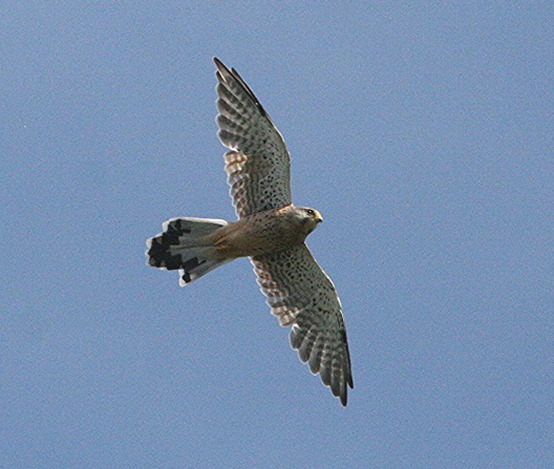
The pointed wings of
the bird suggest a falcon. One cannot gauge the size
of the bird from the photo, but the black tip to the
tail seems to indicate Kestrel. However, when I asked
Malcolm about this, he said it did not fly or hover
like a Kestrel. He said it was going round in circles
and gliding a lot. He wondered if it could be a Hen
Harrier. Well, that would be an exciting first for
Brook Meadow! Does anyone else have any idea what it
might be?
Malcolm also got this
nice shot of what looks like young Swallows -
not a common sight on Brook Meadow.
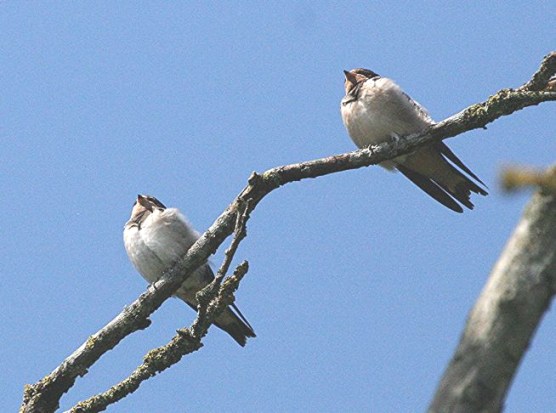
Mint
Moth
I was
interested to see three Mint Moths (Pyrausta
aurata) feeding on the flowering mint plants in
our garden this afternoon. This is a very common moth
to be seen flying around gardens and meadows. It has
two generations; in May and June, and again through
July and August. The larvae feed on mints.
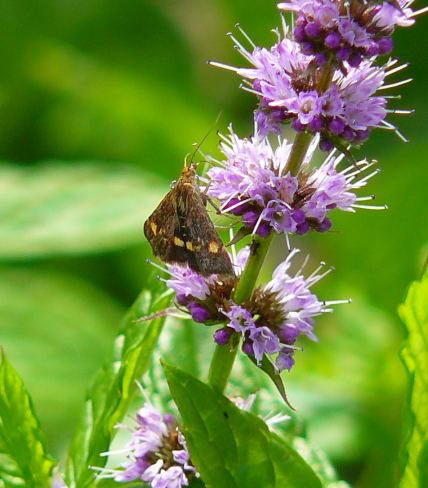
Oak
leaves with brown areas
Ralph Hollins
thinks the Oak leaf with brown marks that I included
in yesterday's blog could be the work of a leaf-mining
moth caterpillar but he stresses he is not at all
certain. Ralph gives the following link to a web site
with information about these creatures . . .
http://www.extension.umn.edu/garden/diagnose/plant/deciduous/oak/leavesbrownspots.html
- scroll down to 'Page 3 of 6'.
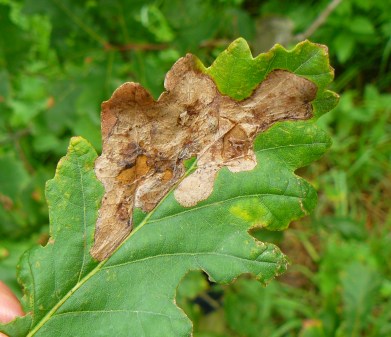
Having looked closely
at one of the affected leaves with the microscope I
think Ralph is correct. The brown areas consist of two
thin skins which can be pulled apart to reveal lots of
tiny dark nodules, which look like excreta of the
grubs that were eating their way through the leaf.
Also, the images of oak leaves affected by leaf miner
are exactly the same as those on the Brook Meadow
tree. Interestingly, Wikipedia says that when leaf
miner larvae attack English Oak, they selectively feed
on tissues containing lower levels of tannin, which is
a deterrent chemical produced in great abundance by
the tree.
THURSDAY
AUGUST 20 - 2015
Brook
Meadow
I went over to
Brook Meadow this morning for the regular 3rd Thursday
in the month conservation work session. The weather
was overcast and humid and the ground very wet after
yesterday's rain. The session was attended by 12
volunteers and led by Ian Newman. The main job was to
prepare the meadow for the annual cutting by Martin
Cull later this month. The power scythe was used to
mark out the areas for cutting and overhanging trees
were lopped to allow room for Martin's tractor.
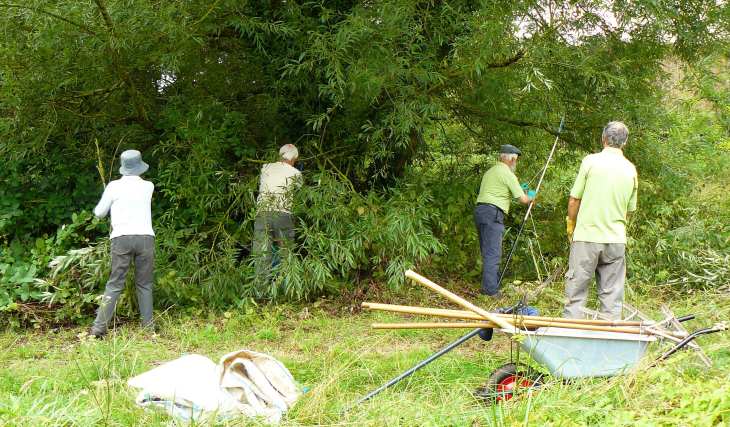
An Alder sapling
donated by Frances Jannaway before she moved away from
Emsworth was planted on the eastern side of the Lumley
area near the Lumley Stream.
Wildlife
observations
There is a
fine display of Hoary Ragwort both on the
orchid area and on the centre meadow. No sign anywhere
of Common Ragwort. Also looking good were the tall
umbellifers of Wild Angelica the flowers of
which were attracting hordes of flies and other
insects. The bright pink blossom of Hemp
Agrimony is showing well on the orchid area.
Common Knapweed looks particularly fine against
the yellow of Common Fleabane on the Lumley area.
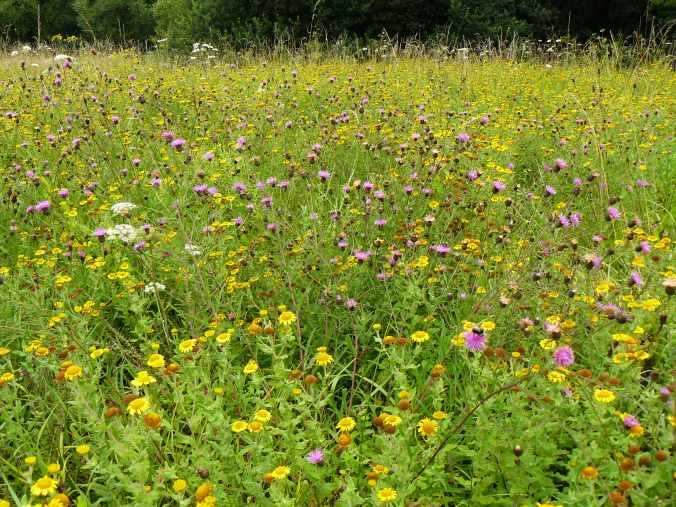
I had a look at the
Oak saplings on the Seagull Lane patch which
are all growing well. However, they support a variety
of galls, produced by the larvae of Gall Wasps which
lay eggs on the tree. When the eggs hatch the tissues
of the tree swell up around the grubs to form the
galls. I found lots of Spangle galls on the leaves
(top left) and a few Marble galls (top right) and
Knopper galls which distort the acorns (bottom left).
Some leaves have brown areas which could be caused by
a fungus (bottom right).
WEDNESDAY
AUGUST 19 - 2015
Mystery
grub
Ralph Hollins
provided the answer to Jill Stanley's mystery grub
that she dug up from her garden yesterday. It is a
Stag Beetle larva. Ralph provides the following useful
link to its life history and larval stage at . . .
http://maria.fremlin.de/stagbeetles/index.html
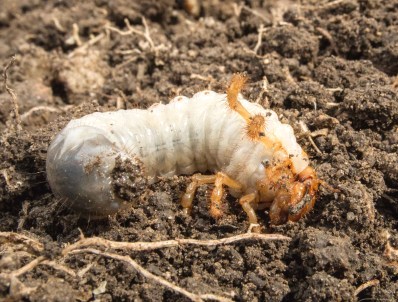
Dead
racing pigeon
As to the dead
racing pigeon that Tom Bickerton found in Havant
Thicket yesterday, Ralph Hollins thinks it would have
been brought down by a young Peregrine. A Sparrowhawk
(which was Tom's suggestion) would have no chance of
catching it and Peregrines kill by breaking the neck
of the prey which would explain the wound around the
neck.
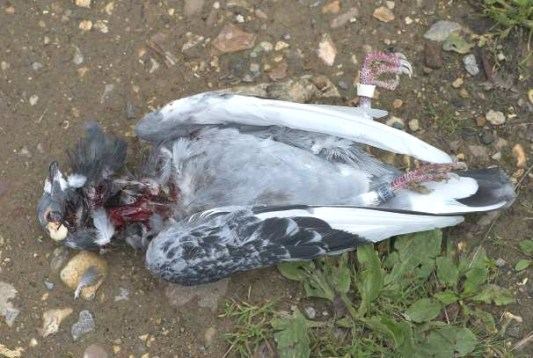
However, Tom Bickerton
disagrees and sticks to his opinion that the culprit
was a Sparrowhawk. He says . . .
"Four reasons, head's still on, first thing an adult
perry does is remove head. I've lost count on the
number of perry kills I've witnessed or photographed,
and heads I've collected. Second both male and female
can carry the carcass away, why remain on a busy path,
when there's a lovely big field 25 yards away. Three
the bird was undamaged, if taken from the sky then I
would expect damage, plus the wings extended out.
Adult peregrines are very surgical in the way they
eat. This was, but controlled to max the meat in a
short period of time. Four, it's the territory of a
Sparrowhawk pair, they nested just by the pond this
year. No, this bird was taken by the Sparrowhawk, on
the ground from behind, you can see gravel embedded in
the cheek, this was due to the force of
impact."
Regarding the Pigeon's
ring number Ralph suggests Tom should go to . . .
http://www.rpra.org/
and click the 'Report a Stray Pigeon' button so that
the Royal Racing Pigeon Association can inform the
owner of the pigeon of its fate.
Flood
protection work on Brook Meadow
As previously
reported in this blog on Aug 4, the Environment Agency
has already carried out extensive clearance work by
removing brambles and other vegetation from the bund
between the Brook Meadow south meadow and the garden
of Gooseberry Cottage. Most of the Bramble hedge has
gone, though our prized patch of Marsh Woundwort at
the northern end has survived - just!
This photo shows the already cleared bank on the left
- looking south along the path. Gooseberry Cottage is
on the other side of the bank on the left and the
south meadow on the right.
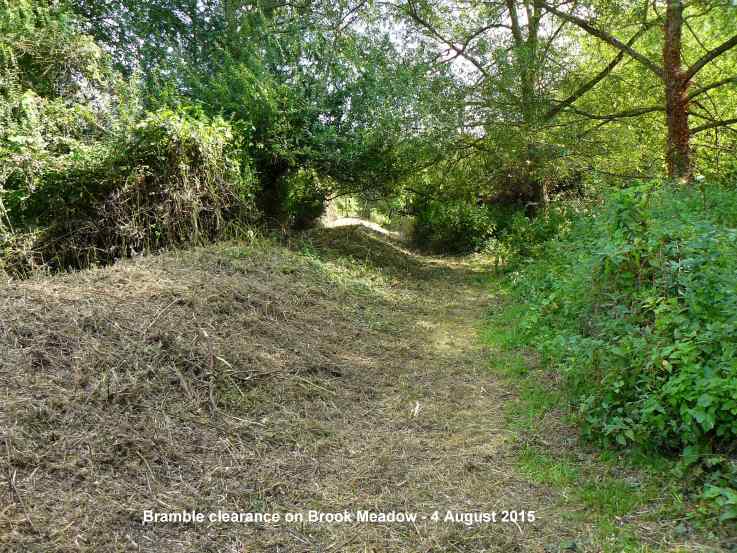
Maurice Lillie now
provides more details about the proposed work by the
Environment Agency to the bank between the South
Meadow and the garden of Gooseberry Cottage. He says
the vegetation that was cut down along the bank will
be allowed to regrow. The work is being carried out by
the EA under the special powers that they have when
responding to flood situations. The EA has assured
Maurice that they have obtained necessary approvals
from Havant Borough Council, Natural England and the
coastal protection organisation. Maurice has produced
a sketch of a cross section through the bank that runs
along the east side of the south meadow and shows the
proposal as confirmed by the Agency.
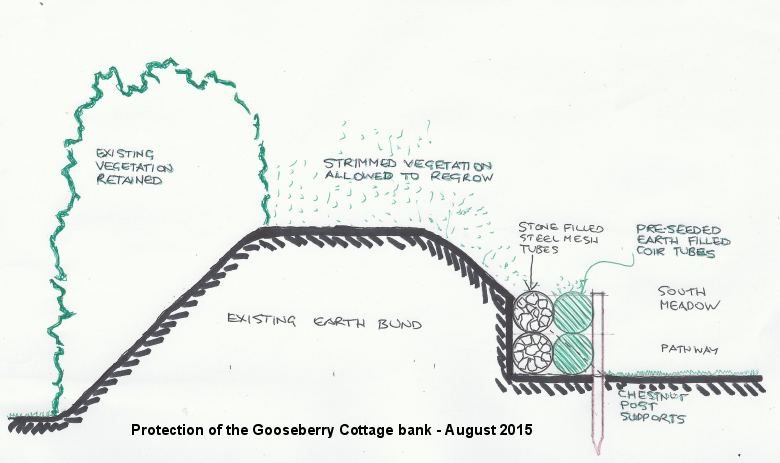
They plan is to start
work on the far south end part this coming weekend
(Aug 22-23). This is to remove the front face of the
concrete structure through which a small diameter pipe
passes to convey flood water through a much larger
pipe to Peter Pond. This job includes leaving the main
structure in place but, by removing the front wall
will allow a far greater quantity of water to pass
more quickly to the pond. The west facing "hole" will
be protected by a childproof grill which will also
serve to trap any debris that arrives there. The Peter
Pond end of the discharge pipe will have a flap
mounted on it to prevent tidal surge from flooding
back to the Meadow.
The planned work to the bund bank will proceed as soon
as materials can be provided and labour resources
assembled. It is intended that the work will be
carried out at weekend and the present duration
forecast is five weekends. The access to carry out the
work will be from the Lumley Road gateway into Brook
Meadow and the EA will take all reasonable precautions
not to disrupt the use of that entrance by the
public.
Are
gulls a menace?
Summer
headlines about gull attacks are not unusual, but this
year the stories have been particularly numerous, and
the claims particularly serious, leading to David
Cameron calling for a "big conversation" about gulls.
The British Trust for Ornithology has been carrying
out gull research for many decades, and is well placed
to clarify the facts on the behaviours that brings
gulls into conflict with humans, as this short very
well reasoned piece shows . . . http://bto-enews.org/IG4-3L55N-3RN36S-1Q9S7F-0/c.aspx
TUESDAY
AUGUST 18 - 2015
Emsworth
- Westbourne
Jean and I had
a nostalgic stroll through the fields from Emsworth to
Westbourne and back through Lumley. We got to know
these fields very well as we lived for 30 years in
Westbourne Avenue where they were readily accessible
over our garden wall.
We loved to pick the juicy Blackberries for
pies and wine and today there was the usual fine crop
of berries in the bushes. However, I was rather sad to
find the northern most of the old Oaks in the
field had finally given up the ghost and toppled over.
I had watched this old Oak over the years, gradually
losing its leaves and branches. But no doubt lots of
wildlife still continues to flourish within its trunk
and bark, so I hope the tree will not be removed. As
the following photo shows the tree also looks very
good even though it is on the ground.
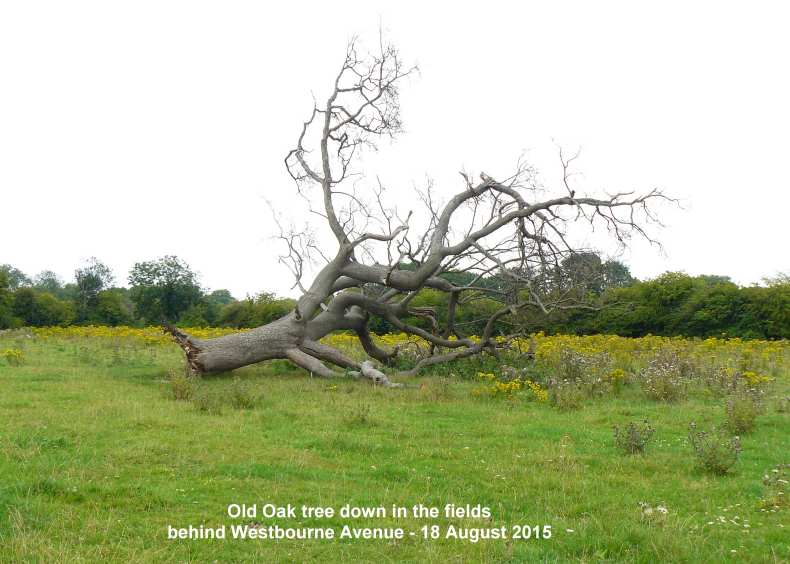
I was very surprised
to see so much Common Ragwort flowering in the
fields (see the above photo), much more than I recall
when we used to live nearby. A local man told me that
7 young bullocks had been grazing the grass in the
fields, but not touching the Ragwort, of course.
Walking back along the river path from Westbourne I
heard my first autumn song of a Robin, a rather
thin and wistful song in comparison with the strong
and vigorous spring song.
I was particularly looking forward to seeing the
Perforate St John's-wort that lines the bridge
over the A27 near Lumley. It was quite magnificent
with its bright red seed heads showing well. I picked
a few stems as they make a fine decoration for my desk
and will last through the winter. At the southern end
of the bridge the glossy brown flower heads of
Jointed Rush were shining even though there was
no sun.
The path coming down
from the A27 bridge was lined with many wild flowers
including Stone Parsley, Rough Chervil and Common
Knapweed. Sadly, there was no sign of any Swallows
around Lumley Mill Farm where they always used to
nest. Have they deserted this site?
Rare
plant on the edge
Two plants of
the rare Narrow-leaved Water-plantain
(Alisma lanceolata) have grown and flowered
in the Westbrook Stream immediately behind our back
garden. Sadly, there are no longer any plants in the
stream through Bridge Road car park.
Malcolm's
pics
Malcolm
Phillips got another couple of excellent photos of the
Brook Meadow wildlife today. Another shot of a Painted
Lady - I have yet to see this lovely butterfly. And a
splendid shot of a Meadow Grasshopper - note its very
short wings, probably female.
Warblington
shore
Peter
Milinets-Raby was out this morning for a walk along
the Warblington shore (6:24am to 8:36am - low tide). A
dull grey day and a dull selection of birds with very
few migrants.
Ibis Field: 10 Stock Doves, 2 Teal flew off the cress
beds and headed to the coast.
Hedgerow behind Conigar Point, After much searching
and "pishing", just 1 Willow Warbler.
Conigar Point: 28 Dunlin, 14 Ringed Plover, 2 Common
Gull, 11 Grey Plover, 1 Common Tern, 2 Great
Black-backed Gulls, 1 Willow Warbler in Tamarisk
Hedge.
Off Pook Lane: 5 Greenshank (one coloured ringed
N//R+RY//-), 1 Dunlin, 14 Grey Plover, 1 Whimbrel, 2
Common Gull.
Langstone Mill Pond: A pair of Gadwall in eclipse
plumage, Interesting plumage and consequently they
were the best sighting of the morning! 1 Reed Warbler,
11 Little Egrets - getting quiet. Grey Heron young
still in nest in the top of the Holm Oak
Mystery
grub
Jill Stanley
While unearthed this very strange creature as she was
digging out the roots of a plant in her garden this
morning. She's never seen anything like it before when
I've been gardening! Nor have I. Jill's guess (and it
is only a wild guess!) is that it might be the larva
of some sort of beetle.
She says it seemed
anxious to get underground again and was squirming
around. It has three pairs of legs at the front and
its skin is quite glossy and opalescent with tiny
ginger hairs. It occurred to me that the gingery legs
might belong to another creature that was attacking
the grub, but they appear to be firmly attached to the
grub's body. Has anyone got any ideas?
Who
killed the Racing Pigeon?
Tom Bickerton
sent this rather gruesome photo of a dead racing
pigeon he found in Havant Thicket and considers how it
met its grizzly end.
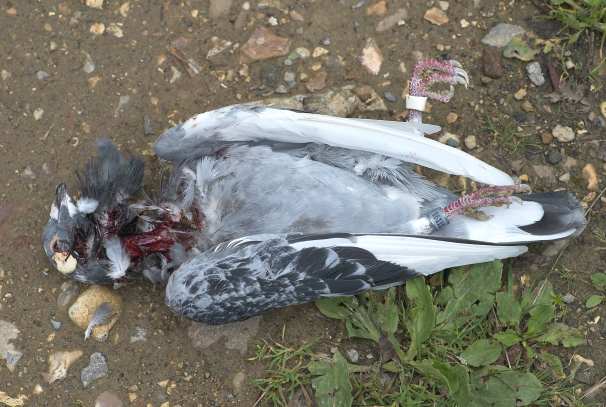
Here is Tom's
interpretation of the scene. "I think an adult
Sparrowhawk, probably a male, killed this bird. Now it
has to be empathised that a Sparrowhawks chances of
catching a fully fit racing pigeon in the open sky are
zero. So what happened? Well something made this bird
come down into the forest, maybe it needed water, or
it had become disorientation, through climatic
conditions, whatever the cause it proved a big mistake
because there it met it nemesis.
I think it was taken on the ground by surprise, shock
probably killing it, there's no struggle marks or
feathers out of place, the wings are nicely folded and
feet splayed apart indicating downward force. Why not
peregrine, buzzard? Well the head's still in place,
both species can carry off the carcass if they had
too. Why adult? The feeding is not frenzied; the
juveniles rip apart the prey.
If we look at the picture feeding has taken place
around the prime choices of meat, the neck area, this
is a case of eating as fast as you can before
disturbance. No bird of prey gives up on such a good
meal, that's why I think the male did the dirty deed.
A female is bigger and has the strength to drag away
the prey; there was no sign of this. Neither bird is
capable of carrying away the prey without the
disembowelment of the pigeon.
Obviously something like this gets my full attention,
after scanning all the trees for the culprit, I
decided to hide and wait for the return, alas too many
dog walkers, and cyclists use this path. The feral
pigeon is an important prey species for the
Sparrowhawk. I found another two older pluckings that
morning of pigeon within the wood. This pigeon had the
misfortune to descend down over the hunting territory
of a Sparrowhawk, once it did that, it gave up any
advantage of speed and acceleration it had over the
hawk."
Red
Squirrels on the Island
Graham Petrie
spotted this handsome Red Squirrel while he and his
family were waiting for the car ferry at Fishbourne on
the Isle of Wight. They were in the Fishbourne Inn car
park and had a good view of two Squirrels taking
advantage of some feeders in an adjacent garden.
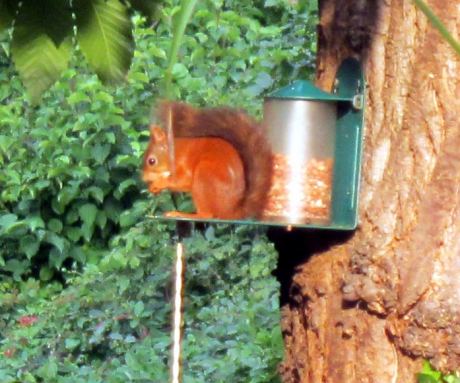
I also recall seeing
Red Squirrels on the feeders in this garden a few
years ago, so look out for them if you are visiting
the Island. It is such a nice introduction to the Isle
of Wight where these beautiful creatures are
widespread and come to feeders.
MONDAY
17 AUGUST - 2015
Emsworth
Harbour
10:00 - 11:00
- I spent about an hour walking along the marina
seawall and the Wickor Bank. Phew! It was very hot and
humid with little wind. The tide was rising to high
water at about 14:00. There were lots of Black-tailed
Godwits (82) and Redshank (50+) plus smaller numbers
of Greenshank, Turnstone and Curlew.
Two colour-ringed Black-tailed Godwits: G+WR
(4th sighting this season and 116th overall) and
O+WL (3rd this season).
Two colour-ringed Greenshank G+BL tag (last
seen 12-Aug-15 and 3 times in 2014) and G+GG
(last seen 17-Sep-14).
Here are digiscoped photos of two of the ringed birds.
Brook
Meadow news
Malcolm
Phillips sent me a selection of photos that he took on
Brook Meadow this morning. Two that grabbed my
attention were a Long-tailed Tit with a cheeky
look in its eye and a cracking image of a Small
Copper butterfly.
Trout
species
Malcolm
Phillips had another look at the fish to the north of
Peter Pond from the Lumley Path foot bridge. He sent
two photos which he says show the difference between a
Brook Trout and a Brown Trout. From what fish expert
Steve Hooper told him the one that has spots with
'pupils' is a Brook Trout (top) and the other
is a Brown Trout (bottom).
Green
Shield Bug nymph
Chris Oakley
sent me the following photo of a bug that he found on
his garden dahlias. It took him ages to identify it,
but finally nailed it as a nymph of a Common Green
Shield Bug (Palomena prasina).
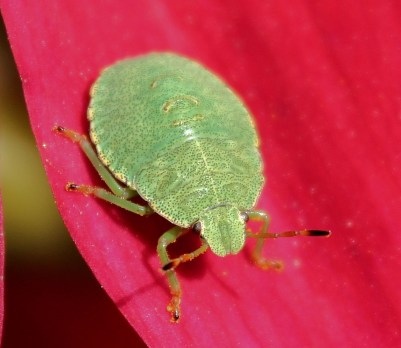
I gather from
Chinery's 'Collins Guide to Insects' that nymph bugs
go through five instars during their development in
which they gradually get more like the adults. There
is a nymph illustrated on page 75 of my old edition of
Chinery. The whole range of nymphs is shown on the
British Bugs web site and Chris's one looks like the
final instar before it becomes an adult.
Go to . . . . http://www.britishbugs.org.uk/heteroptera/Pentatomidae/palomena_prasina.html
For
earlier observations go to . . August
1-16